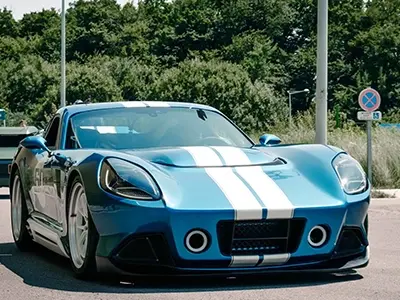
Creating unique cars by hand requires not only deep knowledge and engineering skills, but also a true passion for technology, aesthetics and the history of motorsport. This is the passion demonstrated by twenty-five students from the Swiss design school Espera Sbarro, when in just five months they not only designed on paper, but built a fully-fledged running prototype of a spectacular coupe called Heritage ESX with their own hands. This car, inspired by the legendary Shelby Daytona Coupe, is not a copy or an upgrade of the old body, but is a completely new car that carries the spirit of the racing past, organically combined with the technical and stylistic solutions of today. Thanks to the original approach of the students, the car received a unique appearance, preserving the recognizable features of the Daytona, but is now presented in a modern look, which could well be a production model of the concept class.
The front of the car stands out with its bold and carefully thought-out design: a combination of LED optics from the modern Ford Puma crossover with separate round lights in the lower part of the bumper gives the Heritage ESX a dynamic and modern look, while the air intake slots and ventilated hood add severity and functional expressiveness. The rear part is made in an original manner with a massive integrated ducktail spoiler, four rounded lights and additional ventilation channels on the sides. The whole composition is complemented by large white wheels with a diameter of nineteen inches, shod with low-profile tires, and a rich blue body color with a white racing stripe and the number "60", which emphasize the conceptual tribute to racing traditions. The interior of the car offers a harmonious combination of old-school architecture and modern details: among them are carbon fiber inserts, analog stopwatches in front of the passenger, a central display and a sports three-spoke steering wheel located next to a high gearshift knob, emphasizing the character of the racing car.
Structurally, the car is built on a tubular space frame, providing the necessary rigidity with low weight. The body is made of lightweight and durable fiberglass, which allowed to keep the weight within just a little over one ton - specifically, eleven and a half hundredweight. The proven five-liter naturally aspirated V8 from Ford is used as a power unit, aggregated with a six-speed manual transmission and rear-wheel drive. Thanks to this configuration, the car not only has an impressive visual image, but is also capable of real driving, providing dynamics corresponding to the racing image. And we are not talking about ostentatious power for the sake of an exhibition stand, but about a real functional prototype that is capable of moving and participating in demonstration races, which will be proven during the official presentation of the car at the legendary Le Mans Classic festival, which will be held from the third to the sixth of July this year.
Considering the scale of the project, as well as the fact that the car was developed by a student team in a limited time, the result can rightfully be considered a great achievement in the educational and engineering fields. The Heritage ESX project was the result of a successful educational process and a clear example of how theoretical knowledge can be transformed into a functional result worthy of the attention of the world public and industry professionals. Most likely, this example will remain the only one, as is often the case with conceptual projects of such schools, but the very fact of its existence already puts it among the most interesting modern prototypes. And even if it does not go into serial production, the created model will become a powerful step in the career growth of all those who had a hand in its creation. Perhaps these young engineers and designers will soon shape the appearance of cars of the future.

